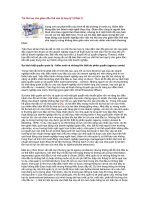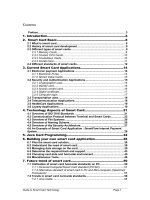Tài liệu McGraw.Hill.Value Investing Today doc
Bạn đang xem bản rút gọn của tài liệu. Xem và tải ngay bản đầy đủ của tài liệu tại đây (1.94 MB, 238 trang )
VALUE
INVESTING
TODAY
FM_Brandes_141738-9 8/14/03 2:51 PM Page i
This page intentionally left blank.
VALUE
INVESTING
TODAY
Charles H. Brandes
Third Edition
McGraw-Hill
New York Chicago San Francisco Lisbon London
Madrid Mexico City Milan New Delhi
San Juan Seoul Singapore
Sydney Toronto
FM_Brandes_141738-9 8/14/03 2:51 PM Page iii
America. Except as permitted under the United States Copyright Act of 1976, no part of this publication
may be reproduced or distributed in any form or by any means, or stored in a database or retrieval
system, without the prior written permission of the publisher.
0-07-143628-6
The material in this eBook also appears in the print version of this title: 0-07-141738-9
All trademarks are trademarks of their respective owners. Rather than put a trademark symbol after
every occurrence of a trademarked name, we use names in an editorial fashion only, and to the benefit
of the trademark owner, with no intention of infringement of the trademark. Where such designations
appear in this book, they have been printed with initial caps.
McGraw-Hill eBooks are available at special quantity discounts to use as premiums and sales pro-
motions, or for use in corporate training programs. For more information, please contact George
Hoare, Special Sales, at or (212) 904-4069.
TERMS OF USE
This is a copyrighted work and The McGraw-Hill Companies, Inc. (“McGraw-Hill”) and its licensors
reserve all rights in and to the work. Use of this work is subject to these terms. Except as permitted
under the Copyright Act of 1976 and the right to store and retrieve one copy of the work, you may not
decompile, disassemble, reverse engineer, reproduce, modify, create derivative works based upon,
transmit, distribute, disseminate, sell, publish or sublicense the work or any part of it without
McGraw-Hill’s prior consent. You may use the work for your own noncommercial and personal use;
any other use of the work is strictly prohibited. Your right to use the work may be terminated if you
fail to comply with these terms.
THE WORK IS PROVIDED “AS IS”. McGRAW-HILL AND ITS LICENSORS MAKE NO GUAR-
ANTEES OR WARRANTIES AS TO THE ACCURACY, ADEQUACY OR COMPLETENESS OF
OR RESULTS TO BE OBTAINED FROM USING THE WORK, INCLUDING ANY INFORMA-
TION THAT CAN BE ACCESSED THROUGH THE WORK VIA HYPERLINK OR OTHERWISE,
AND EXPRESSLY DISCLAIM ANY WARRANTY, EXPRESS OR IMPLIED, INCLUDING BUT
NOT LIMITED TO IMPLIED WARRANTIES OF MERCHANTABILITY OR FITNESS FOR A
PARTICULAR PURPOSE. McGraw-Hill and its licensors do not warrant or guarantee that the func-
tions contained in the work will meet your requirements or that its operation will be uninterrupted or
error free. Neither McGraw-Hill nor its licensors shall be liable to you or anyone else for any inac-
curacy, error or omission, regardless of cause, in the work or for any damages resulting therefrom.
McGraw-Hill has no responsibility for the content of any information accessed through the work.
Under no circumstances shall McGraw-Hill and/or its licensors be liable for any indirect, incidental,
special, punitive, consequential or similar damages that result from the use of or inability to use the
work, even if any of them has been advised of the possibility of such damages. This limitation of lia-
bility shall apply to any claim or cause whatsoever whether such claim or cause arises in contract, tort
or otherwise.
DOI: 10.1036/0071436286
ebook_copyright 6x9.qxd 10/21/03 10:28 AM Page 1
Copyright © 2004 by Charles H. Brandes. All rights reserved. Manufactured in the United States of
To L. F. B.
FM_Brandes_141738-9 8/14/03 2:51 PM Page v
This page intentionally left blank.
Contents
Preface ix
Introduction xi
Part 1. What Is Value Investing and Why It Makes Dollars
and Sense 1
1 What Is “Value Investing”? 3
2 Behavioral Biases: Why Value Investing Works 17
3 The Value Pedigree and the Rewards of Value Investing 31
Part 2. How to Find Value Companies 47
4 Characteristics of Value 49
5 Narrowing Your Focus 61
6 Gathering Company Information 71
7 Corporate Governance and the Value Investor 79
Part 3. Learning to Think Globally 95
8 Why Go Overseas? 97
9 How to Invest in Companies Worldwide 119
10 Unique Aspects of Global Investing 139
Part 4. Value Investing and You 157
11 Managing Risks and Your Value Portfolio 159
12 Are Stocks an Intelligent Investment? 173
vii
FM_Brandes_141738-9 8/14/03 2:51 PM Page vii
For more information about this title, click here.
Copyright 2004 by Charles H. Brandes. Click Here for Terms of Use.
13 Staying the Course 185
14 Above All, Be Patient 203
Epilogue 207
Index 209
viii
CONTENTS
FM_Brandes_141738-9 8/14/03 2:51 PM Page viii
Preface
environment also has changed quite a bit from when the second edition was
published in 1998. From advances in technology, medicine, and communi-
cation to broader adoption of free enterprise practices and free trade agree-
ments, today’s world reflects unprecedented opportunity—and unique
risks. Yet through all the changes, I believe the essential principles of suc-
cessful investing endure.
Updated with new chapters, sections, and examples, this third edition
of Value Investing Today seeks to demonstrate how the combination of
rational fundamental analysis and irrational stock market prices can create
opportunity for the diligent value investor.
Throughout this book, I frequently cite the philosophy and writings of
Benjamin Graham. With David Dodd, Graham wrote the cornerstone book
in the canon of investment publications, Security Analysis. Graham also
wrote The Intelligent Investor, a book Warren Buffett called “the best book
about investing ever written.”
1
I had the privilege to meet and learn from
Graham, a man many consider to be the father of security analysis and
value investing. I am greatly indebted to Benjamin Graham, my mentor.
His basic principles formed the solid foundations for my worldwide invest-
ment success.
For help in the preparation of this book, I share my deep appreciation
with my colleagues at Brandes Investment Partners. With the dedication
and hard work of the professionals with whom I work on a daily basis, we
have built a respected investment management firm.
This book was written for investors who understand that the most pre-
cious things in life have to be earned, those who know that quick fixes often
ix
“I
ntelligent investing.”
In many ways, the global investment landscape is far different than
it was in 1989 when I wrote the first edition of this book. Today’s
FM_Brandes_141738-9 8/14/03 2:51 PM Page ix
Copyright 2004 by Charles H. Brandes. Click Here for Terms of Use.
fail just as quickly. In the pages to follow, I’ll discuss my definition of value
investing, why it’s important and why it works, how it can be applied on a
company-by-company basis in markets worldwide, and why I believe it
represents an approach best described as “intelligent investing.”
Notes
1. Warren E. Buffett, preface to The Intelligent Investor: A Book of
Practical Counsel, 4th rev. ed., by Benjamin Graham, New York:
Harper & Row, 1973, p. vii.
x
PREFACE
FM_Brandes_141738-9 8/14/03 2:51 PM Page x
Introduction
Y
ou should focus on two ideas as you read this book. First, as an
investor, you must accept that patience is necessary if large and
enduring profits are to be made from purchasing stocks. Second, be
aware that most investors’ thinking is often misguided. The stock market is
inherently misleading. Often, doing what everybody else is doing can be
wrong. Benjamin Graham, widely considered the father of value investing,
set down his central beliefs on how investors may achieve better-than-average
results in the first chapter of his book The Intelligent Investor. He suggests
investors follow policies that are “inherently sound and promising” and “not
popular in Wall Street.”
1
That’s why Value Investing Today is important to
you. Finding stocks that are “inherently sound and promising” is hard. Hav-
ing the perseverance to buy and hold stocks that are “not popular in Wall
Street” is harder still. In the chapters that follow, I’ll try to provide guidance
on both of these aspects of successful investing.
Graham himself realized that in-depth research and analysis were not
enough. He believed investors must show courage to trust their convictions
and take actions that are out of step with popular consensus. In essence,
achieving better-than-average returns depends upon thinking and acting
differently than the average market participant. Value investors believe that
the low prices they pay for their investments are the result of a temporary
disparity between the fair value of the business and its current market price.
They believe that the gap between price and fair value will close, creating
an opportunity for profit.
I also believe this book is impor-
tant because investors today have
many financial alternatives that
were not around—or effectively
available—during Graham’s life-
time (1894–1976). It is important to
xi
Achieving better-than-
average returns depends
upon thinking and acting
differently than the average
market participant.
FM_Brandes_141738-9 8/14/03 2:51 PM Page xi
Copyright 2004 by Charles H. Brandes. Click Here for Terms of Use.
address several of these issues within the context of Graham’s principles.
There is one segment of readers who I especially believe could benefit
from this book: individual investors with some experience in the market. In
other words, Value Investing Today was not designed as a how-to book for
total novices, nor as a textbook for highly skilled professionals. It should
provide valuable assistance, however, to individual investors who have
taken their first steps. I have spoken with many such investors and have
noted that some have picked up all sorts of investment ideas and notions
that could prove frustrating and expensive.
So, Value Investing Today addresses a philosophy and strategy that can
help individual investors be more successful. As you read this book, you
will discover sound methods of fact gathering and interpretation and begin
to appreciate the need for discipline and patience.
Another point to consider: When I have talked with individual
investors, the most striking aspect of our conversations has been their ten-
dency to set sail on financial oceans without so much as a chart to guide
them. In Value Investing Today, you will find a way to design and imple-
ment a conservative and effective investment philosophy. It is a philosophy,
I emphasize, that has proved to be a successful means of building wealth
and preserving capital.
WHAT TO EXPECT FROM THIS BOOK
This edition of Value Investing Today has been updated with lessons
designed to protect long-term investors from severe losses and help them
develop the discipline and patience to accumulate substantial wealth. The
book includes fresh evidence reinforcing the benefits of value investing
and draws on my more than 30 years in the investment industry.
Beyond mere facts and figures, this edition of Value Investing Today
explores why the value approach to money management has been success-
ful since first introduced by Benjamin Graham in the 1930s. I discuss how
“intelligent” investors can apply an understanding of human behavior to the
world’s financial markets. Given Graham’s assertion that “the investor’s
chief problem—and even his worst enemy—is likely to be himself,”
2
the
book also provides practical advice on how investors can develop the
patience and discipline they need to succeed through value investing. In
addition, I share insights gleaned firsthand from Graham when I became his
acquaintance.
xii
INTRODUCTION
FM_Brandes_141738-9 8/14/03 2:51 PM Page xii
My main purpose in writing this book is to help you take advantage of
true investment opportunities by supplying you with the principles of the
most successful means of investing over the past 70 years: value investing.
I will admit to being a convert to this approach and, as with many converts, I
am deeply committed to it. I have seen the results; I know it works; and I’m
confident it can build wealth for those who apply its principles.
Notes
1. Benjamin Graham, The Intelligent Investor: A Book of Practical
Counsel, 4th rev. ed. New York: Harper & Row, 1973, p. 13.
2. Ibid., p. xv.
INTRODUCTION
xiii
FM_Brandes_141738-9 8/14/03 2:51 PM Page xiii
This page intentionally left blank.
VALUE
INVESTING
TODAY
FM_Brandes_141738-9 8/14/03 2:51 PM Page xv
This page intentionally left blank.
What Is Value
Investing and
Why It Makes
Dollars and
Sense
1
PA RT
The goal in Part 1 is to define value investing and establish
clearly that the combination of rational fundamental analysis
and irrational market prices creates opportunity for value
investors. As such, Part 1 is designed to address value-investing
principles, illustrate why the approach works, and deliver his-
torical evidence supporting its merits.
1
Brandes_Ch01_141738-9 8/14/03 2:36 PM Page 1
Copyright 2004 by Charles H. Brandes. Click Here for Terms of Use.
This page intentionally left blank.
WHAT IS “VALUE
INVESTING”?
1
W
hich is a better value—a stock selling at $5 per share or a stock
selling at $25 per share? If your answer hasn’t already sprung to
mind, be aware. The correct response is not the $5 stock. Nor is
it the $25 stock.
The correct answer is that you can’t tell. You can tell which is a lower-
priced stock. But “lower price” isn’t always synonymous with “better
value.” With the limited information I provided about these two stocks, you
cannot make an informed decision about which is the better value. Share
price is an important consideration when investing in stocks, but it’s only
one of two important factors to evaluate. The other vital factor is underly-
ing business value.
If I went to the grocery store and purchased two items—one for $5 and
one for $25—and asked you which was the better value, you would say,
“Well, that depends. What did you buy?”
If I told you that I bought one onion for $5 and a 50-pound box of sir-
loin steaks for $25, you’d quickly recognize that I probably paid far too
much for the onion, but got a great bargain on the steaks.
The price you pay for something—whether onions or steaks or
stocks—is only relevant as it relates to its underlying value. This is the
essence of value investing, that is, purchasing shares of a company at a
price that is substantially lower than the company’s underlying value.
3
CHAPTER
Brandes_Ch01_141738-9 8/14/03 2:36 PM Page 3
Copyright 2004 by Charles H. Brandes. Click Here for Terms of Use.
4
WHAT IS VALUE INVESTING AND WHY IT MAKES DOLLARS AND SENSE
Some people believe there is no difference between share price and
business worth. They believe that if you buy shares of stock in a company
for $30 a share, they must be worth $30 a share. I disagree. I believe price
is what you pay; value is what you get. As cited earlier, it’s the same con-
cept when bargain hunting at the grocery store.
In practice, applying the value-investing philosophy is straightforward.
Find companies with measurable worth. When their stock is selling at a
price below that worth, buy it. In time, as others recognize these values, the
stock’s price likely will rise. When that happens, sell it and redeploy the
proceeds to other undervalued companies.
Adherence to this approach has produced solid results for many long-
term investors. I’ll elaborate on and document the success of this strategy
in greater detail in Chapter 3. Throughout this book, I’ll also explore a
number of concepts as they relate to the value-investing philosophy and
process, building on the core principle contained in the previous paragraph.
Let’s start with a concept known as the “margin of safety.”
THE MARGIN OF SAFETY
Benjamin Graham, often thought of as the man who pioneered value
investing, challenged himself to “distill the secret of sound investment into
three words”
1
when he wrote The Intelligent Investor, a book published in
1949. The three words Graham chose were “margin of safety.” What does
this three-word phrase mean?
For value investors, the margin of safety represents the difference
between a company’s stock price and the value of the underlying business
of that company, often called its intrinsic value. Generally, value
investors are not interested in stocks that trade at a slight discount to their
underlying value. Rather, they seek a substantial discrepancy. Why? They
are looking for solid companies whose stock prices are selling at “pen-
nies on the dollar” compared with the intrinsic values of the businesses
they represent. Value investors believe that a large margin of safety pro-
vides greater return potential as well as a greater degree of protection
over the long term.
Graham believed that purchasing stocks at sizable discounts would
protect investors against permanent loss and allow them to dispense with
the need for making accurate estimates of the future. I’ll discuss this in
greater detail when I examine the differences between value and growth
investing.
Brandes_Ch01_141738-9 8/14/03 2:36 PM Page 4
Before I do that, I want to illustrate the margin of safety concept using
two charts. In Exhibit 1-1, a horizontal line represents a hypothetical com-
pany’s intrinsic value—the underlying value of the business. Later in this
book, I’ll explain how this value is derived. For now, understand that a com-
pany’s intrinsic value does not change that often and certainly not as fre-
quently as its stock price, which may change from day to day and moment
to moment.
In addition to the company’s intrinsic value, I show in Exhibit 1-1 an
example of a value investor’s required discount to that intrinsic value. In
other words, this is the gap between the intrinsic value and the price at
which shares of the company would be purchased. Keep in mind that when
purchasing shares, I seek a significant discount to intrinsic value, otherwise
known as a large margin of safety.
In Exhibit 1-2, I add a line representing how the company’s stock price
fluctuates over time. You’ll notice the stock price rises above and falls
below the company’s intrinsic value. These price fluctuations create oppor-
tunities for value investors. When the stock price of the company falls suf-
ficiently below the intrinsic value, it creates a buying opportunity. The
shaded area between the company’s stock price and its discount to intrinsic
value illustrates when value investors should consider purchasing the stock.
Value investors expect that over time, as others recognize the true value
of the company, its share price will climb toward its intrinsic value. As this
happens, the margin of safety shrinks. When the share price equals or
exceeds the company’s intrinsic value, the margin of safety has disappeared
and the shares should be sold.
CHAPTER 1 WHAT IS “VALUE INVESTING”?
5
Intrinsic Value
Discount to
Intrinsic Value
Time
EXHIBIT 1-1 The Margin of Safety Concept
Brandes_Ch01_141738-9 8/14/03 2:36 PM Page 5
Hopefully, these exhibits provide a clear illustration of how the value-
investment philosophy is applied. On paper, the logic of this approach
may appear obvious: buy stocks at a bargain price and sell them after the
price has gone up. However, investment decisions are not made in the-
ory. They are made in an ever-changing environment where logic can be
overshadowed by emotion. I’ll address this point in greater detail
throughout the book and offer guidance on how investors can help pro-
tect themselves by maintaining strict adherence to this value-investment
principle.
Often, it takes a great deal of conviction to stick to value-investment
disciplines, especially when a company’s stock price declines after you
purchase its shares. For those who focus only on price, share price
declines can be devastating emotionally. Even worse, this can lead to bad
decisions, such as selling just because the price is down. Some market
participants only focus on how much a stock’s price has declined in the
short term. However, for long-term investors who evaluate share price
in relation to business value, price declines can represent tremendous
opportunity.
To me, investors are those who have the confidence and patience to
back their judgment by buying stocks that they are prepared to hold for 5
years or more if needed. If you are looking for a quick way to turn a profit
in the stock market, this book is not for you. Value investors do not focus
on day-to-day oscillations in share price. They adopt and maintain a disci-
plined approach for evaluating business value. They are confident of their
research and analysis and patient in implementing their strategy.
6
WHAT IS VALUE INVESTING AND WHY IT MAKES DOLLARS AND SENSE
Sell Zone
Buy Zone
Stock Price
Intrinsic Value
Discount to
Intrinsic Value
Time
EXHIBIT 1-2 The Margin of Safety Concept
Brandes_Ch01_141738-9 8/14/03 2:36 PM Page 6
VALUE AND GROWTH
INVESTING
In recent years, it’s become more
popular to classify investors’ ap-
proaches as being either “value”
or “growth.” These have become
accepted as being polar opposites,
almost like taking sides in a sports
event: do you support “value” or
“growth”? You may not be sur-
prised that I reject this popular
approach to classifying investment
styles. Value and growth are not
enemies, nor are they based on
incompatible beliefs. For investors
(in contrast with speculators, whom I’ll address below), company funda-
mentals support either a value or a growth approach to selecting stocks. I
believe that value investing is the more profitable discipline in the long
term, but there are many successful, fundamental growth investors. How-
ever, most speculators consider themselves “growth investors,” and it’s
among this group that I expect to see a high failure rate.
Even at the stock level, let’s be clear. I do not believe in classifying
stocks as value or growth. Often, such generalizations reflect guidelines
imposed by index sponsors and have little or nothing to do with fundamen-
tal analysis at the individual company level. During my 30+ years of prac-
tical investment experience, I have investigated companies all over the
world in every sector and industry. With the goal of uncovering investment
opportunities that offer the greatest margin of safety, the search has led me
to undervalued businesses in what many may perceive to be growth indus-
tries such as technology or pharmaceuticals.
I encourage you to discard any preconceptions you may have regarding
value investing. It’s not a purely defensive tactic that should be applied only
in bear markets. It does not focus exclusively on backward-looking busi-
nesses in dying industries. And value investors do not buy stock only in
companies that “make things that rust,” as I once heard someone say. The
diligent value investor searches for promising investments offering a large
margin of safety—in whatever country or industry they may be.
Many times, I see promising businesses behind what many people call
growth stocks: solid, well-established companies that offer quality products
CHAPTER 1 WHAT IS “VALUE INVESTING”?
7
Company-specific
fundamental research and
analysis enable the value
investor to assess intrinsic
business value, independent
of the volatility of short-term
stock price movements. In
my experience, a portfolio
of securities, bought at a
discount to intrinsic value,
has provided superior
long-term returns.
Brandes_Ch01_141738-9 8/14/03 2:36 PM Page 7
or services. But I will not consider them for purchase if their stock prices
far exceed their underlying business worth—in other words, if they offer no
margin of safety.
Near the peak of the Internet stock mania in early 2000, share prices for
various dot-com or “New Economy” companies (many of which were not
solid or established and offered unproven products or services) were leap-
ing to successive record highs. At the same time, share prices languished
for “Old Economy” companies in industries such as insurance, utilities,
and manufacturing. At that point, some market participants mistakenly
believed that New Economy growth stocks were stocks that went up, while
Old Economy value stocks were those that went down.
Returns for value and growth stock indices appeared to support this
notion. By the end of March 2000—even as technology stocks began their
retreat—the Nasdaq 100, a measure of returns for the 100 largest compa-
nies in the technology-heavy Nasdaq Composite, had gained 108.7 percent
in the prior 12 months versus only 13.3 percent for the venerable Dow
Jones Industrial Average (DJIA). The DJIA measures returns for 30 major
U.S. companies. Technology stocks, spurred by shares of start-up Internet
firms, were soaring while it seemed the rest of the market was being left
behind, some said “for good.”
In fact, many of the best-performing stocks at the time were initial pub-
lic offerings or IPOs—companies that had never issued stock before. Of the
486 IPOs in 1999, about half were Internet-related companies that gained,
on average, 147 percent their first day of trading. Exhibit 1-3 illustrates the
divergent paths of technology growth stocks, as measured by the Nasdaq
100, versus the broader market, as measured by the S&P 500 Index.
At that time, I believed this divergence between growth and value
stocks represented the biggest two-tiered market bubble that I had seen
since starting my career in 1968. I didn’t believe the gains were sustainable
because the prices for so many stocks climbed to ridiculous heights—lev-
els that were well beyond the intrinsic values of the underlying companies.
While I was scratching my head over the market’s ridiculous excesses, my
firm was taking advantage of that environment by adding to our portfolios
solid businesses trading at extremely attractive prices. I was more excited
about the opportunities available for value investors, especially in the
United States, than I had been in nearly 20 years.
When the bubble burst in March 2000, the majority of dot-com stocks
offered no margin of safety. In the wake of huge losses, market participants
returned their attention to fundamental strengths and the “out-of-favor”
stocks my firm had purchased during the Internet-stock run-up were once
8
WHAT IS VALUE INVESTING AND WHY IT MAKES DOLLARS AND SENSE
Brandes_Ch01_141738-9 8/14/03 2:36 PM Page 8









